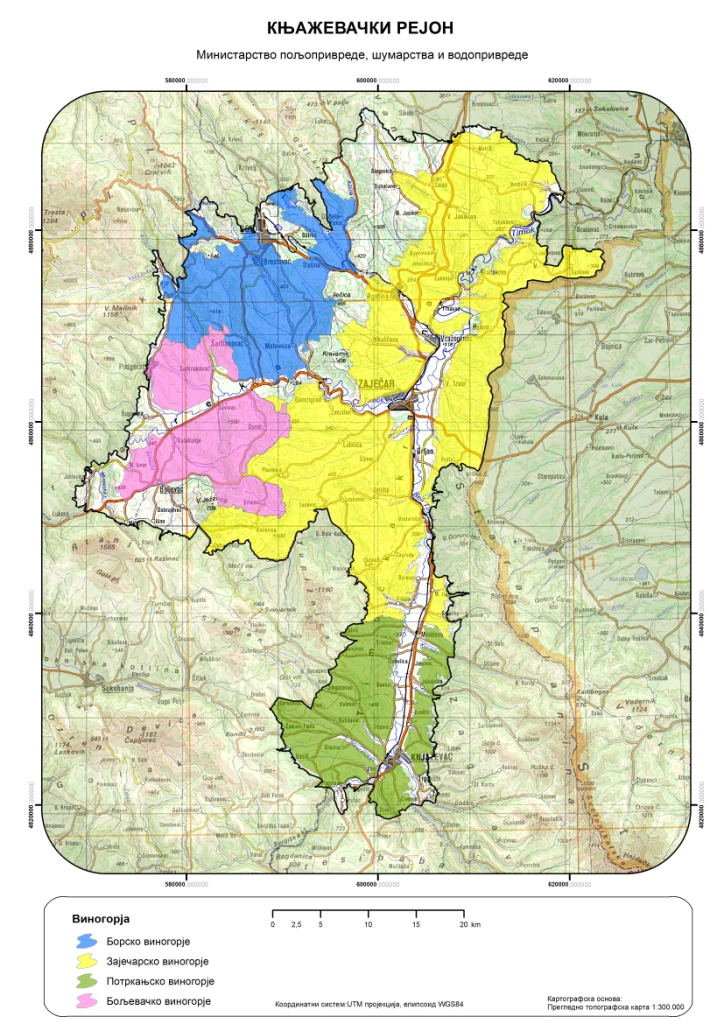Wine regions
Wine regions / 01/22/2019 / 2624
Knjaževac wine region is surrounded on all sides by mountains in the basin of upper Timok River, on the territory of the towns of Zaječar, Bor, Boljevac and Knjaževac. It comprises 4 sub-regions: Bor, Boljevac, Zaječar and Potrkanje, with the largest area under vineyards in the municipality of Zaječar.
According to 2012 data, there are 1,076 hectares of vineyards in Knjaževac region. The vineyards spread at the altitude ranging from 220 to 400 meters, at moderately steep to gentle slopes of terrain.
Soil: The predominant type of soil is Vertisol, and to a lesser extent both Cambisol and other soil types.
The moderating factor affecting the microclimate are the mountains surrounding the area: Deli Jovan (1141m), Crni Vrh (1043m), Malinik (1158m), Rtanj (1565m), Tupižnica (1160m), Tresibaba (787m).
Grape Producers: 6,473 households own vineyards in this wine region. The largest number of vineyards is in the municipality of Zaječar.
Varieties: Rhine Riesling, Cabernet Sauvignon, Italian Riesling, Chardonnay, Pinot Noir, Sauvignon Blanc, Merlot, Muscat Hamburg, Vranac
Interesting trivia:
-For decades, Agricultural cooperative Džervin has been the most reputed winery from Knjaževac region. In 1922, Bogdan Arandjelović owned 4.5 hectares of vineyards. He sent his oldest grandson Radul Bogdanović to study at the winemaking school in Bukovo near Negotin. After graduation, Radul suggested setting up a cooperative in order to increase production capacity. Soon afterwards, Bogdan and five other wealthy citizens of Knjaževac invested a portion of necessary funds, whilst several hundred small shareholders from Knjaževac and surrounding villages invested the remaining share capital, so the fruit and vinegrowing cooperative was founded on March 27th, 1927. Already in 1929, the cooperative had the first harvest under the supervision of a retired German oenologist from Vršac and Radul Bogdanović. This triggerred rapid development of winemaking in Knjaževac region. This was the beginning of Džervin, as remembered by Radul’s descendants… After the Second World War, the wine cellar got expanded and the private wine cooperative Džervin became state-owned. Radul Bogdanović left Knjaževac and worked as an oenologist in Tunisia, Navip, Strumica and Veles. In 1960, the vinegrowing and fruit-growing cooperative merged with the state-owned agricultural estate Timok to form Džervin Cooperative Cellar. The name Džervin indicates business activities of the cooperative ( DŽE= jams (“džemovi”), R = brandy (“rakija”) , VIN = wine (vino)). During 1990s, Džervin went through a period of hardships. Decline in production was followed by unsuccessful attempts to restore former production volumes. Failed privatizations in the first decade of the 21st century have led to further collapse of Džervin’s potential. Finally, in 2013, current owners take over the ruined company and initiate gradual revitalization of fruit and grape production.
-Knjaževac wine region is the easternmost area where the Mediterranean variety Vranac is grown.


Tomislav Ivanović
Awarded wine writer, wine critic and contributor to selected wine magazines. WSET3-certified author and editor-in-chief of www.vinopedia.rs. Member of Vojvodina Sommelier Association. Juror in national and international wine competitions. Lecturing about wines of Serbia and the Balkans. Local partner of Wine Mosaic organization. Co-founder of International Prokupac Day.

Pročitajte i druge članke iz ove rubrike:


SEVERNA METOHIJA
PROČITAJ VIŠE


VRANJE
PROČITAJ VIŠE


NIŠ
PROČITAJ VIŠE


KNJAŽEVAC
PROČITAJ VIŠE


ŠUMADIJA
PROČITAJ VIŠE
Winner MILLESIMA BLOG AWARD 2016

Pobednik MILLESIMA BLOG AWARD 2016
VINO & FINO wine personality of the year 2016

VINO & FINO vinska ličnost godine 2016